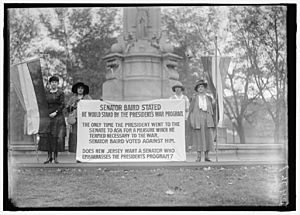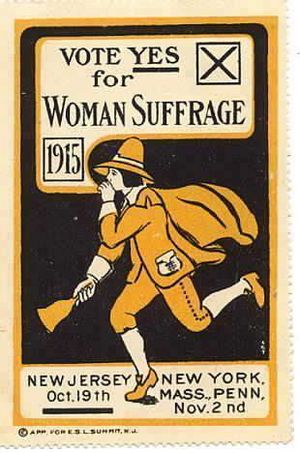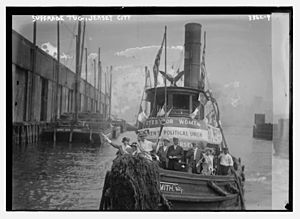Timeline of women's suffrage in New Jersey facts for kids
This is a timeline of how women in New Jersey fought for their right to vote. Believe it or not, women and African Americans actually had the right to vote in New Jersey for a while! But in 1807, the state changed its constitution, taking away this right from everyone except white men.
One of the first protests for women's voting rights happened in 1857. A woman named Lucy Stone refused to pay her property taxes because she couldn't vote. She believed it was unfair to pay taxes if she had no say in the government. Over the years, many people worked to make women more equal under the law. There were also several court cases that tried to challenge whether women could vote.
Eventually, in 1915, New Jersey held a special vote to decide if women should get the right to vote through a change in the state constitution. Sadly, the idea was voted down. But activists didn't give up! They kept fighting in New Jersey and even protested in Washington, D.C. as "Silent Sentinels" outside the White House. Their hard work paid off. On February 10, 1920, New Jersey officially approved the Nineteenth Amendment to the U.S. Constitution, which finally gave women across the country the right to vote!
Contents
- Early Voting Rights for Women
- Losing and Fighting for the Vote
- The 1800s: Rights Taken Away
- The 1820s: A Few Votes Still Cast
- The 1840s: A New Constitution Excludes Women
- The 1850s: Early Protests Begin
- The 1860s: Forming Groups and Mock Votes
- The 1870s: Removing "White" from Voting Rules
- The 1880s: School Voting Rights
- The 1890s: Court Challenges to Women's Votes
- The Fight Continues in the 20th Century
Early Voting Rights for Women
The 1770s: Voting for Property Owners
1776
- The first Constitution of New Jersey allowed both men and women who owned enough property to vote.
The 1780s: Women on Voting Lists
1787
- Records show that two women were listed on a New Jersey voting list.
The 1790s: More Women Vote
1797
- October 18: A poem about women's right to vote was printed in the Centinel of Freedom newspaper in Newark.
- After this year, many more women in New Jersey started voting.
Losing and Fighting for the Vote
The 1800s: Rights Taken Away
1802
- In Hunterdon County, both African Americans and women voted.
1807
- Women in New Jersey lost their right to vote. The state claimed this was "election reform," but it took away voting rights from many people.
The 1820s: A Few Votes Still Cast
1824
The 1840s: A New Constitution Excludes Women
1844
- June 18: John C. Ten Eyck asked the New Jersey Constitutional Convention to include women's right to vote in the new state constitution.
- However, the new state constitution clearly stated that women and African Americans could not vote.
The 1850s: Early Protests Begin
1852
- Many women from New Jersey attended the Pennsylvania Woman's Convention at West Chester in 1852, a meeting about women's rights.
1853
- John Pierpont talked about how women in New Jersey used to have voting rights at a Women's Rights Convention in Rochester.
1854
- Henry Lafetra asked the state lawmakers to make women and men equal under the law.
1857
- Lucy Stone refused to pay property taxes on her home in Orange. She argued it was "taxation without representation" since she couldn't vote.
- Lafetra sent another request to the state to make women and men equal.
1858
- Some of Lucy Stone's belongings were sold to pay her unpaid taxes.
The 1860s: Forming Groups and Mock Votes
1866
- The Vineland Equal Suffrage Association was created.
1867
- The New Jersey Woman Suffrage Association (NJWSA) was started by Lucy Stone and Antoinette Brown Blackwell.
- Stone and Blackwell asked the state lawmakers to remove the words "white male" from the state constitution's voting rules.
- Stone spoke to a group of lawmakers, arguing that women and Black people should be allowed to vote.
1868
- March 10: Portia Gage tried to vote in New Jersey.
- November: Women in Vineland held "mock ballots" as a way to protest for women's suffrage. There were 172 participants, including four Black women.
The 1870s: Removing "White" from Voting Rules
1872
- Women in New Jersey continued to take part in protest votes.
1875
- The word "white" was removed from the list of voter requirements in the state constitution.
The 1880s: School Voting Rights
1880
- November 2: Elizabeth Cady Stanton tried to vote in Tenafly.
1884
- A request for full voting rights for women was given to the state lawmakers.
- Therese Walling Seabrook, Henry Blackwell, and Phebe Hanaford gained some support for women's suffrage among state lawmakers.
1887
- February: A bill was introduced to allow all people, regardless of race or sex, to vote in school meetings. It was introduced by William Miller Baird.
- Women in New Jersey gained the right to vote in school elections.
- The New Jersey Woman's Christian Temperance Union (WCTU) voted to support women's right to vote.
- September: Seabrook and Lillie Devereux Blake encouraged women to protest by voting in the next election, but it's not known if anyone did.
The 1890s: Court Challenges to Women's Votes
1890
- The NJWSA was reorganized with help from Mary Dudley Hussey.
1893
- A law passed in New Jersey allowing any property owner (which could include women) to vote for local road commissioners.
- Women voted in a school meeting that involved a tax levy (a local tax).
1894
- June 11: In the case Allison v. Blake, women's votes were ruled unconstitutional.
- June 13: Women lost the right to vote for school trustees, but could still vote on some school issues after a Supreme Court of New Jersey ruling in Allison v. Blake.
- July 27: Women's votes were rejected during a school election.
- November: The case of Kimball v. Hendee dealt with the rejected votes from July 27. The Court decided that women voting was against the constitution.
1895
- February: Landis v. Ashworth decided an issue about women voting on a tax levy in 1893. It was ruled that women could vote for everything except school trustees.
- The NJWSA and the Jersey City Woman's Club supported women's right to work as lawyers. They helped Mary Philbrook become the first woman allowed to practice law in New Jersey. Philbrook then became a legal advisor for NJWSA.
1897
- Efforts to pass a bill for school voting rights in the state legislature failed.
1898
- The Orange Political Study Club (OPSC) was started by Minola Graham Sexton.
The Fight Continues in the 20th Century
The 1900s: New Groups Form
1902
- Minola Graham Sexton began holding meetings about women's right to vote in Ocean Grove.
1904
- Sexton gave speeches at women's clubs and the New Jersey WCTU.
1906
- Supporters of women's suffrage held a memorial meeting in Orange to honor Susan B. Anthony after her death.
1908
- Mina Van Winkle started the Equality League for Self Supporting Women of New Jersey.
1909
- Emma O. Gantz and Martha Klatschken formed the Progressive Woman Suffrage Society.
- Sophia Loebinger gave a speech at Palisades Amusement Park. She talked about how Native American traditions influenced the women's suffrage movement.
The 1910s: Parades, Protests, and a Big Vote
1910
- The Equal Franchise Society of New Jersey (EFSNJ) was organized.
- March: The New Jersey Men's League for Woman Suffrage marched in Plainfield.
- A state convention for women's suffrage was held in Plainfield.
- New Jersey suffragists marched in the New York City suffrage parade, organized by Harriot Stanton Blatch.
1911
- November: The state suffrage convention was held in Passaic.
- November: Mary Philbrook went with Harriet Carpenter to watch her try to register to vote. Philbrook then filed a lawsuit, Carpenter v. Cornish, to challenge why women couldn't vote.
- December 4: The NJWSA arranged for Emmeline Pankhurst, a famous British suffragist, to speak in Newark. About 2,000 people attended.
- The Equal Justice League was created in Bayonne.
- Between 80 and 100 suffragists from New Jersey participated in the New York City parade.
- The EFSNJ started a campaign to teach women in New Jersey about equal voting rights.
- Several New Jersey suffrage groups joined together to form a committee to work with lawmakers.
1912
- January: State senator William C. Gebhardt proposed a women's suffrage amendment in the state legislature.
- March 13: A public hearing on the state suffrage amendment was held, with about 600 people attending.
- April 11: Carpenter v. Cornish was a court case in the state. It argued that the 1844 New Jersey state constitution was wrong to take away women's voting rights. The court decided against women's right to vote.
- April 14: The New Jersey Association Opposed to Woman Suffrage (NJAOWS) was formed.
- October 25: A women's suffrage parade was held in Newark with about 1,000 men and women marching.
- The Equality League, led by Mina Van Winkle, changed its name to the Women's Political Union of New Jersey (WPUNJ) and joined with NJWSA.
- Alice Paul became a co-leader of the Congressional Committee of NAWSA.
1913
- January: A resolution for women's suffrage was introduced in the state legislature.
- February: A "Votes for Women Special" train left Newark to take suffrage supporters to Trenton. They went to support an upcoming bill for women's right to vote.
- March: A women's suffrage amendment passed the state legislature.
- March 3: A group from New Jersey joined the Woman Suffrage Procession in Washington D.C.
- April: Alice Paul and Lucy Burns started the Congressional Union for Woman Suffrage (CU).
- June: The first state conference of the Women's Political Union was held.
- August 4: The amendment text needed to be published by this date to be valid. It wasn't, which made the bill invalid.
- November: The state suffrage convention was held in Newark.
- November: 73 delegates from New Jersey tried to meet with President Woodrow Wilson about women's suffrage. They eventually marched in without an invitation and spoke to President Wilson, who talked about starting a Suffrage Committee in the House of Representatives.
1914

- April: The NJWSA headquarters moved to Plainfield.
- A women's suffrage amendment bill passed in the state legislature, but it needed to pass one more time.
1915
- May 6: A women's suffrage bill passed and was ready for a public vote.
- August 7: The Suffrage Torch was passed to New Jersey activists on a tugboat, the A.W. Smith, in the middle of the Hudson River.
- August 13: The NJWSA hosted an event in Orange to celebrate Lucy Stone and her tax protest.
- October: Mary Church Terrell campaigned in New Jersey, asking Black men to support women's right to vote.
- October 19: The women's suffrage amendment was defeated in the public vote.
- December 1: The New Jersey chapter of the Congressional Union for Woman Suffrage was formed, with Alison Turnbull Hopkins as its president.
1916
- January: The state suffrage convention was held in Elizabeth.
- February: A bill for presidential suffrage (allowing women to vote for president) went to the state legislature but did not pass.
- June: Lillian Feickert and others represented New Jersey suffragists at the National Republican Convention in Chicago.
- September: The NAWSA held their yearly convention in Atlantic City.
- November: The NJWSA held a convention in Jersey City.
1917
- February: A state suffrage amendment was successfully moving through the state legislature.
- A presidential suffrage bill failed in the state legislature.
- The New Jersey State Federation of Women's Clubs (NJSFWC) officially supported women's right to vote.
- March: The New Jersey CU changed its name to the National Woman's Party (NWP) New Jersey branch. Members of the NWP of New Jersey began to protest outside the White House.
- July: The WPU of New Jersey closed down, and its members joined the NJWSA.
- November: The yearly state suffrage convention was held in Trenton. The State Federation of Colored Women's Clubs was accepted as a partner of the NJWSA.
1919
- February 10: New Jersey Senator David Baird Sr. blocked the passage of the federal suffrage amendment.
- April 23: The NJWSA celebrated the ratification and changed into the League of Women Voters of New Jersey.
- May: The yearly state suffrage convention was held in Atlantic City.
- December: The Men's Council for Ratification was organized.
The 1920s: Victory!
1920
- January: The state legislature considered approving the federal suffrage amendment.
- January 27: A large meeting attended by 1,200 women and "most of the Legislature" was held in Trenton.
- February 10: The New Jersey legislature officially approved the Nineteenth Amendment. This was a huge victory for women's voting rights!
- April 23: The NJWSA officially became the League of Women Voters of New Jersey, continuing to work for informed voters.



